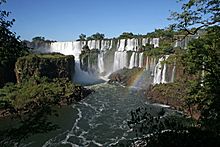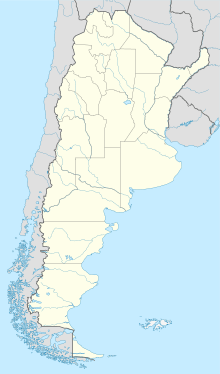Iguazú National Park facts for kids
Quick facts for kids Iguazú National Park |
|
|---|---|
|
IUCN Category II (National Park)
|
|

View of a section of the waterfall
|
|
| Location | Misiones Province, Argentina |
| Area | 677 km2 (261 sq mi) |
| Established | 1934 |
| Governing body | Administración de Parques Nacionales |
| Type: | Natural |
| Criteria: | vii, x |
| Designated: | 1984 (8th session) |
| Reference #: | 303 |
| Region: | Latin America and the Caribbean |
The Iguazú National Park (Spanish: Parque Nacional Iguazú) is a special natural area in Argentina. It's located in the Misiones province, in the northeastern part of the country. This park covers about 677 square kilometers (261 square miles). It was created to protect the amazing Iguazu Falls and the beautiful subtropical jungle around them. The name "Iguazú" comes from the Guaraní language, meaning "large water."
Contents
History of Iguazú National Park
Early Inhabitants and European Arrival
About 10,000 years ago, hunter-gatherers from the Eldoradense culture lived in this area. Around 1,000 CE, the Guaraní arrived. They brought new ways of farming.
In the 16th century, Spanish and Portuguese explorers came to the region. The first European to visit was Álvar Núñez Cabeza de Vaca in 1542. Later, Jesuit missions were set up starting in 1609. The Guaraní culture still has a strong presence here, even in the park's name.
Creation and Protection of the Park
The Iguazú National Park was officially created in 1934. Its main goal was to protect the incredible Iguazu Falls and the rich subtropical jungle surrounding them. These falls are one of Argentina's greatest natural wonders.
Across the Iguazu River in Brazil, there is a similar park called Iguaçu National Park. Both the Argentine and Brazilian parks were recognized as World Heritage Sites by UNESCO in 1984. This means they are considered very important natural places for everyone in the world to protect.
The park also includes the Iguazú National Reserve. While the main park aims to keep nature as untouched as possible, the reserve allows for some human activities and buildings. This helped with building an international airport and hotels for visitors.
Animals and Plants of Iguazú Park
The park is part of the Alto Paraná Atlantic forests ecoregion, which is a very diverse natural area. It's home to many different kinds of animals and plants.
Amazing Animals of the Park
The park is a safe home for many animals, including some that are rare or endangered. You might see a jaguar, which is a large wild cat, or a smaller ocelot. Other animals include the South American tapir, a large mammal, and the anteater.
Many birds live here too, like the black-fronted piping guan and the powerful harpy eagle. You can also spot colorful toucans and the great dusky swift, which flies near the waterfalls. On the ground, you might see coatís, which are curious mammals, and a huge variety of beautiful butterflies. The yacare caiman, a type of crocodile, also lives in the park's waters.
Diverse Plant Life
The Iguazu River flows through the park. Its banks are covered with many types of trees. One important tree is the ceibo, also known as the Cockspur coral tree. Its bright red flower is Argentina's national flower.
Other tall trees in the park include the lapacho negro and lapacho amarillo, which are known for their beautiful flowers. You can also find palmito trees and the very tall palo rosa, which can grow up to 40 meters (130 feet) high.
Gallery
See also
 In Spanish: Parque nacional Iguazú para niños
In Spanish: Parque nacional Iguazú para niños
- Rainforest Ecological Train
- Iguaçu National Park (Brazilian side of the park)
- Iguazu Falls
















